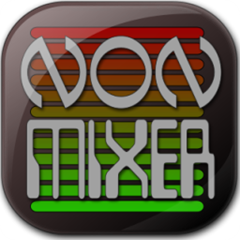 The Non Mixer is a powerful, reliable and fast modular Digital Audio Mixer, released under the GNU General Public License (GPL). It utilizes the JACK Audio Connection Kit for inter-application audio I/O and the FLTK GUI toolkit for a fast and lightweight user interface.
The Non Mixer is a powerful, reliable and fast modular Digital Audio Mixer, released under the GNU General Public License (GPL). It utilizes the JACK Audio Connection Kit for inter-application audio I/O and the FLTK GUI toolkit for a fast and lightweight user interface.Please see the Manual for more information (and lots of screenshots).
At the time work began on Non Mixer, there was no other powerful, fast, and light stand-alone free-software JACK mixer available. There was (and is) LiveMix, however LiveMix is neither fast nor light, and it wasn't able to accept the necessary external control data.
SpiralSynthModular, strangely enough, was the closest thing the author could find to the tool he needed (it has gain/mix modules and all modules accept Control Voltage input). SSM is truly an excellent, if neglected, program, but the modules-on-a-canvas model with manual routing is far too cumbersome of an arrangement for real world mixing tasks. Instead of creating another monolithic DAW with built-in routing and mixing, the author choose to follow the time tested Unix design philosophy of one tool per task. The most obvious point of division is between the timeline and the mixer. Drawing the line here allows routing and mixing to actually occur within JACK, which is an infinitely more flexible arrangement than the alternative.
Features.
Non-Mixer shares many features in common with other, similar projects. However, Non-Mixer's unique architecture permits surprising new functionality.
Stand-alone Implementation.
The Non Mixer is a stand-alone application. It is a complement to Non DAW, but neither program requires the other in order to function.
Implementing the mixer functionality in a separate program, connected to Non-DAW via JACK presents a number of advantages:
Eliminates the need for an internal connection management interface
Improves overall system stability
Increases parallelism (utilizes multiple cores)
Adds flexibility
Eliminates the need for cumbersome concepts and interfaces such as 'sends', 'groups', 'inserts' and 'busses'.
Each mixer strip runs as a separate JACK client. In JACK2, this can translates into the DSP workload being spread across multiple CPU cores.
Since the Mixer is an entirely separate unit, you may use any JACK capable mixer client you want instead of, or in myriad combination with, the Non-DAW Mixer. The one called LiveMix works well, but lacks many features of Non's mixer. All operations on the mixer affect the current mix set state only and are not journaled.
The mixer's design is modular, with all DSP occurring in discrete modules. One module hosts LADSPA plugins and the mixer is capable of receiving control (automation) data for any module parameter from Non-DAW (or another program) via JACK.
Control data is expressed either as Control Voltage (CV) or Control Signals.
Modular Signal Processing.
All signal processing in Non Mixer occurs in Modules. This includes input and output from/to JACK. The modular design helps to restrain the total program complexity, and this in turn increases flexibility and reliability. Even the built-in gain stage and meter are modules (and you can place as many meters as you like, wherever you like, in the signal chain, eliminating the post/pre concept).
Parallel Processing.
Because each mixer strip in Non Mixer runs as a separate JACK client (in its own thread), JACK has the opportunity, upon analysis of the connection graph, to execute some or all strips in parallel. This is a highly desirable behavior for those having multi-CPU and/or multi-core configurations.
Multiple Instances.
Because Non Mixer is stand-alone, it is possible to run multiple instances. One reason you might want to do this is so that you can group sets of strips out of a large total number of strips. For example, you might want to keep all of your drum strips together. By using multiple Non Mixer instances, you are able to manage these groups of strips with the familiar navigation facilities of your chosen window manager. Once again, a modular design allows us to maintain a good balance of complexity across user interface levels without duplicating and internalizing the functionality already available at a higher level.
LADSPA Plugins.
LADSPA plugins are hosted by the Plugin module and can be inserted anywhere in the signal chain (contingent on compatibility of the I/O configuration at that point).
Unlimited Strips.
There is no limit imposed by Non Mixer on the total number of strips or Mixer instances you can create.
Automation.
Spatialization.
Plugins supporting Ambisonics panning are automatically assigned a special control called a Spatializer. This allows for easy and positioning of sound sources.
Screenshots.

Custom Search
If you liked this article, subscribe to the feed by clicking the image below to keep informed about new contents of the blog:



















0 comments:
Post a Comment